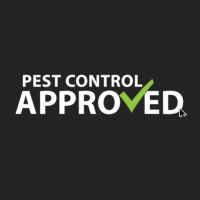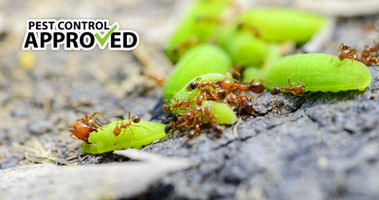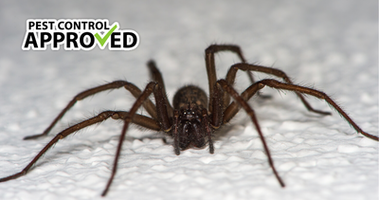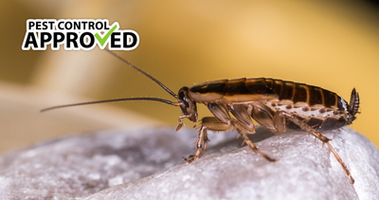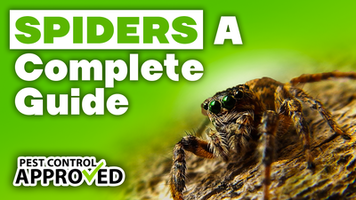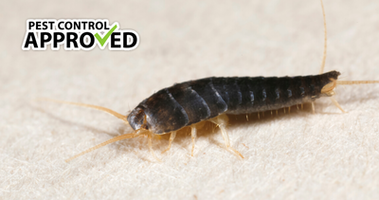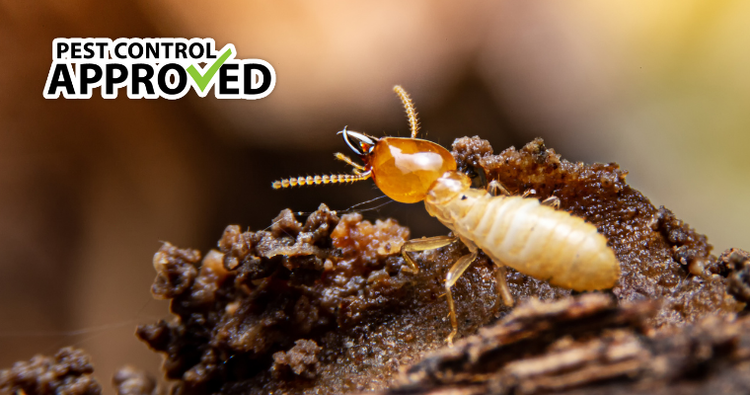
Alone, a single termite is as small as an ant and no more threatening, but they are rarely alone. These creatures may look small and harmless but don’t let your guard down. If you spot one termite, there is probably a whole army behind it. They travel in colonies seeking an optimal food source and survive by building intricate tunnel systems underground which they use to access the above-ground wood. Their favorite target is damp wood; they are most attracted to the moist cabinets and wardrobes in your home. Termites are tenacious and will cause serious damage in their hunt for food.
Damage a Termite Infestation can Cause
Imagining hundreds or thousands of ant-like creatures swarming is frightening, but when it comes to termites, the heebie-jeebies should be far your primary concern. These unwelcome guests cause up to 5 billion dollars worth of damage on a yearly basis in the USA.
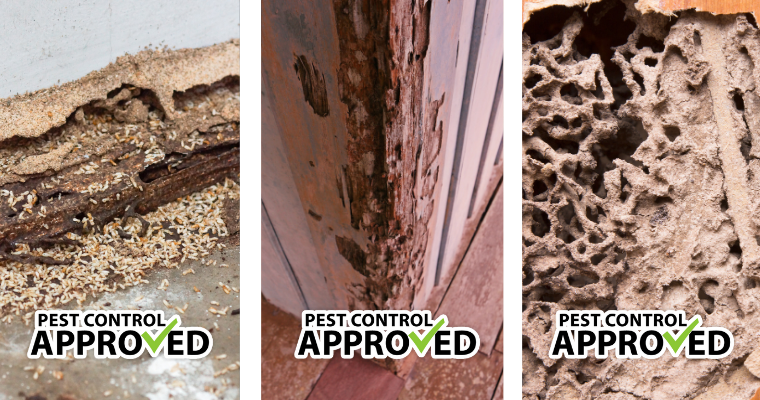
Structural Damages
Termites are extremely efficient and use unparalleled teamwork to invade your house and furniture. Not only do they ruin the cosmetic look of all wood items, they can cause serious structural damage. They eat into the very structure of the building, weakening it from within. Support beams, floors, and ceiling joists are favorite snacks. If that isn’t bad enough, termites don’t limit themselves to wood (even though it is their favorite) but enjoy feeding on metal siding, insulation, and even plaster! If you find obvious signs of termite damage (like on wardrobes or furniture), it is almost certain that the termites have wreaked havoc to the foundation of your house as well. If left to their own devices, termites can make a building make uninhabitable.
Health Concerns
Termites pose the least risk to your health, but this doesn’t mean that you shouldn’t worry. Although they are non-toxic and can’t transmit any diseases to humans, they can still bite and sting. Termite nests contain irritating particles which spread throughout the house via the ventilation system, causing the get asthma attacks or allergic reactions. Allergies to termite saliva or droppings are also common.
The direct health risks from a termite may not seem like a big deal, but they do lower immunity and can make you more susceptible to other unwanted health issues.
Ways to Keep Termites Out of Your Home
Now that you know the damage a termite can cause, you will definitely want to keep them out. Termites are a constant threat and while you can’t always prevent it, there are ways to limit the likelihood of an infestation. To keep termites out of your house, you should follow the measures below:
Eliminate Excess Moisture
Termites prefer damp living conditions, so it’s necessary to keep your home’s humidity down. This means repairing leaky pipes and faucets. Clean up any excess water on plant covers, moss, wood, mulch, and any standing water in eavestroughs or on the roof. All of these dampen the foundation of the building and it is crucial to divert all water from there. You should also unclog any gutters and vents because these help any excess water flow away from your establishment.
Cut Off Termite Food Sources
If there is no way for termites to reach their food source, they will not enter your place. Seal off any entry points around the drain which provide a moist entry point. Keep any wood in your house away from soil, including furniture, firewood, and paper. Termites live in soil and can find their way through it to any wooden objects in your house.
As an additional measure, you should carefully dispose of any wooden stumps or debris outside the house so that it doesn’t attract termites. Pest Control Experts recommend that you build a gravel barrier between any wooden structures (like a porch) and the soil.
How to Identify a Termite Infestation
Termites are very illusive insects and tend to hide away inside the walls, roof, and their underground homes. So, how do you know if your house is infested with termites? Don’t fret, there are many significant signs that point to an infestation.
Head Banging
Yes, you may want to bang your head in frustration when it comes to pests, but this is a different type of head banging. When your house has a termite infestation, the quiet clicking sounds that you can hear from the walls is actually the termite soldiers communicating with the rest of the colony! So, if you hear this sound, you’ll know for sure that there are termites present.
Flying Termites
These swarmers are amongst the first signs of an infestation. Flying termites are those that have left their initial colony and are in search of a new home to colonize. You can spot these flying close to light sources; they most often come out after a spring rain. Be prepared to take action when you’ve spotted even one.
Discarded Wings
When flying termites find a mate and are starting their colony, they will discard their wings. If you spot any insect wings lying about, it is a clear indication that termites have chosen your home as their new home. 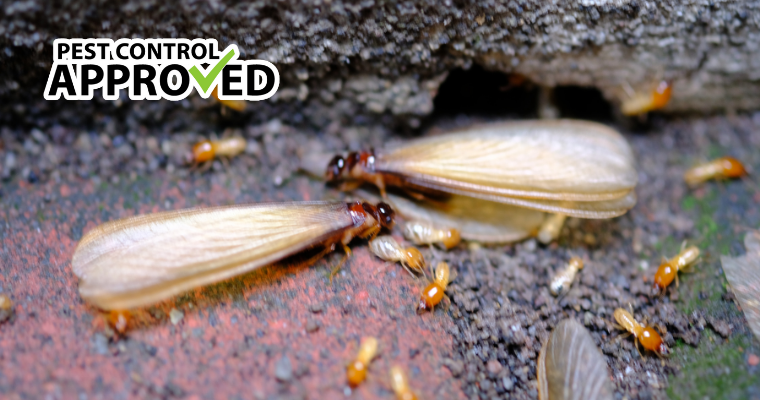
Paper-Thin or Hollow-Sounding Timber
Termites tend to eat wood from the inside out; if you tap on an area inflicted with termite damage, it will sound hollow or papery. This is a clear sign of a full-blown termite infestation because it means that they have already started weakening the home’s structures. Many horror stories are told where people only realizing that they have an infestation when their finger goes through the doorframe after the slightest touch.
Tight Fitting Doors
While termites are happily feeding away, they produce moisture which can warp nearby objects. When termites feed off window and door frames, it reshapes them and makes them hard to open. Of course, hot, humid weather can also cause this, so it is not a clear indication of an infestation.
Tunnels in Wood
Termites exist in channels or long tunnels. While these tunnels are not always visible, they often appear on the exterior of beams.
Termite Droppings (Frass)
Termites push their feces away from their tunnels, which results in small heaps of the powdery substance piling up. Termite droppings resemble sawdust and they not only indicate termite activity, but they also show termites’ location.
Technology
Professionals use technology to carry out a manual investigation. They use moisture, heat, and sound sensors to detect the termites and their exact location.
How to Get Termites Out of Your Home
If you are successful in identifying a termite problem, you must take immediate action before the issue accelerates and leads to serious damage. There are a number of steps you can take to get rid of these pests by yourself.
Insecticides
Insecticides are either directly applied to the infected area or they can be mixed with building materials and then applied. Either way, they involve the termites finding the insecticide and wanting to not only eat it themselves but share it with rest of the colony. While this is a good way to poison active termites, it doesn’t eliminate their growing and inactive population such as larvae and eggs. This means you must be prepared for a second wave of termites.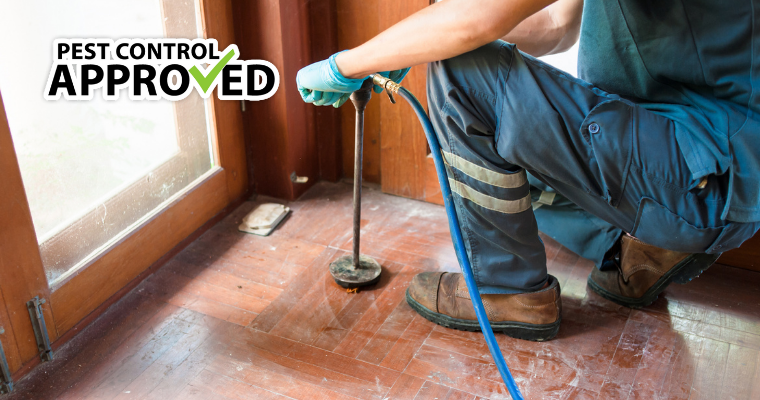
Heat
Using heat is a sure-fire way to get rid of termites, but it is best if it takes place under professional supervision. Otherwise, it could result in a structural fire. By raising the temperature of the area to 60◦C (140◦ F) for at least 35 minutes, the termites will be cut off from their oxygen source. We recommend that this technique be done by professionals.
Orange Oil
Orange oil is the most common household termite treatment. Apply Orange Oil to the affected area destroys termite eggs and break down the termites’ exoskeleton. But studies have shown that this only has a 77 percent mortality rate, which means that a portion of the termite population will manage to survive. When it comes to pests, anything less than a 100 percent mortality rate is just a temporary measure.
Cardboard Traps
Using cardboard traps is a DIY solution that uses bait to attract termites. Since termites are attracted to moist wood, you can set a wet cardboard trap. The idea behind this is that the termites will feed on the cellulose within the cardboard and use it as a new home, moving from the wood to the trap that you can then burn. It is unlikely that the entire colony will move to the box. It is more likely that a new colony will form in the box because it takes only 2 termites to start a colony. If you don’t get rid of every last termite in the house, the infestation will come right back.
Sunlight
You can leave infected furniture out in the sun for a few hours, which will both kill the termites and dry out the wood. As you can’t apply this method to the structure of your house, it must be used with other methods.
Beneficial Nematodes
Nematodes are tiny parasites that exist by feeding off other insects, especially termites. You can release nematodes into the infected furniture or building structure. While they are effective in theory, Beneficial Nematodes are sensitive and can die due to the slightest change in temperature. There is also no guarantee that they will finish off every single last termite. Not to mention that the idea of voluntarily releasing parasites into your home is creepy!
Boric Acid
You can get boric acid almost anywhere from the hardware store to toy stores. It is lethal to termites and you can use it as a spot treatment. The termites will ingest it along with the wood and will be poisoned. However, it is very difficult to reach the entire colony without any professional tools or experience.
Diatomaceous Earth
Diatoms are tiny aquatic organisms with a silica exoskeleton. Their fossilized remains are used to make this specialized earth. When used as a spot treatment, the silica from the Diatomaceous Earth reacts with the termites exoskeletons and causes them to dry out and die. You can spread this over exposed wood to act as a barrier to termites. While this may hinder the colony’s growth and even kill a lot of termites, this won’t reach into the structure of the house.
Pest Control Service: Termite Exterminator
DIY home remedies against termites may seem like a good idea but you may end up spending more money. Hiring a professional can save you money and frustration. An exterminator is a trained professional who will clean up the problem in a matter of hours where it would have taken you weeks. 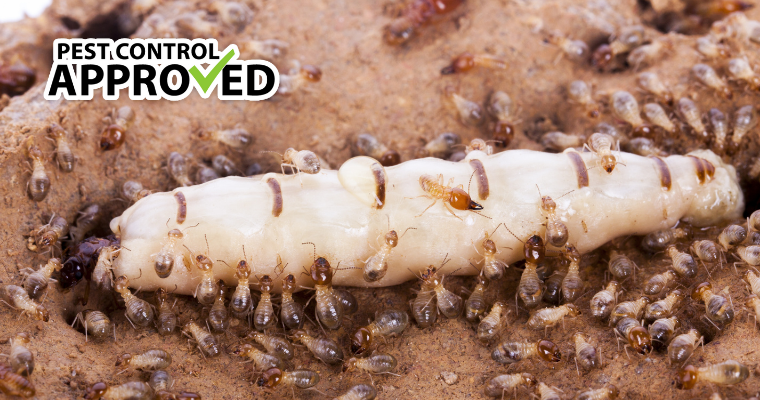
When to Call an Exterminator?
Termite infestations can go on aboveground and underground for years before showing any visible signs to the inhabitants’ building. If you suspect an infestation, have a professional check out your establishment. They are trained to fully understand and deal with all kinds of infestations. Some businesses have a yearly inspection for termites.
Most DIY attempts are not effective on termites due to their large colonies and their ability to reproduce exponentially. When you try to fight the infestation on your own, this small issue can turn into a large one as the termites continue to multiply.
Experts recommend that you immediately call an exterminator to minimize long term damage and costs. If the situation is dealt with early on, there will be less destruction to your building’s structure and less expense.
Questions to Ask Before Hiring an Exterminator
You’re paying for the service and you need to make sure you are getting the best quality. Don’t be shy when questioning your exterminator! After all, this is a matter of your household’s safety and your wallet.
Here is a list of things that you should ask for when hiring an exterminator:
1) Credentials
No one wants to get scammed. The best way to make sure that you’re hiring a legitimate company is by asking for credentials. True pest control specialists can back up their expertise with certificates and a license of service. Never hesitate to check if the team of exterminators are trained by asking for their license and certification details. Re-check this information by using public registry and confirm the legality when you are looking to hire.
On the same note, it is important to ask about professional experience, like the number of years the company been in business and how often has the exterminator undertaken a similar situation. This will tell you the experience level of your prospective pest control and will reassure you that they can manage the situation.
2) References
Any good company will be able to back up their claims. Ask for a list of previous customers so you can assess the individual’s experience and expertise. It’s crucial to know if the company was able to satisfy its former customers or if your money will be wasted.
If it’s not possible to ask for references, then use your friends, family, and neighbors as a source of information. A person whose opinion you trust is sure to point you to the best exterminator in your area. It is important to note that if a company isn’t providing any references, you shouldn’t hire them.
3) Chemicals Being Used
While the most common method used by exterminators is trapping, they also heavily rely on pesticides. There are many different pesticides available, so it is a good idea to ask your exterminator for a list of what they’re planning to use, along with their individual specifications. The specifications should include registration numbers, restrictions, clean-up methods, and possible antidotes. These will help you sanitize your home after the exterminators leave and prepare you for any accidents if your pets or children come into contact with these chemicals.
Fumigation is also used for termite removal but only as a last resort because it means exposing yourself and your loved ones to harmful gasses. You will have to vacate the building for a few days, but the fumigation gasses will disperse into the environment and may have long-term effects.
4) Guarantees
For quality assurance and customer satisfaction, most pest control services offer guarantees. These include a warranty for a certain period of time. If the infestation resurfaces during this time, the company will be held accountable and will take care of the problem for no extra cost.
These guarantees can also include inspection visits after the extermination process. For a certain period of time afterwards, you will have professional protection to ensure the unwelcome insects are permanently gone. The longer the warranty period offered by the company, the longer your establishment will be protected.
5) Number of Visits
The extent of the infestation, the size of the property, and the damage already done to the structure determine how many visits will be required from the company. The exterminator should discuss all of these details with you after the initial inspection and specify them in the service agreement. There is no pest control method that fits every infestation or establishment, so this question will help you get an idea of what the future entails.
Termite Services and Their Cost
Termite removal costs start from $1400 CAD and $5400 CAD. This figure isn’t an arbitrary amount decided by the pest control company, but an accumulation of factors like:
- Property Size: With larger establishments, it takes longer to seal entry points.
- Severity of Infestation: The more densely populated the pests are, the more it will cost to have them exterminated.
- Accessibility of Infestation: Often, areas like the roof, inside of the walls, and the foundation are places that are difficult to reach. This means that they will require more effort and hence a higher cost of extradition.
- Services: There are different types of termite removal methods and each has its own price point.
There are a few standard services that exterminators employ when dealing with termite removal. Each service can be used on its own or in combination with others. This is entirely dependent on the level of infestation and what your pest control determines is the best way to solve the issue.
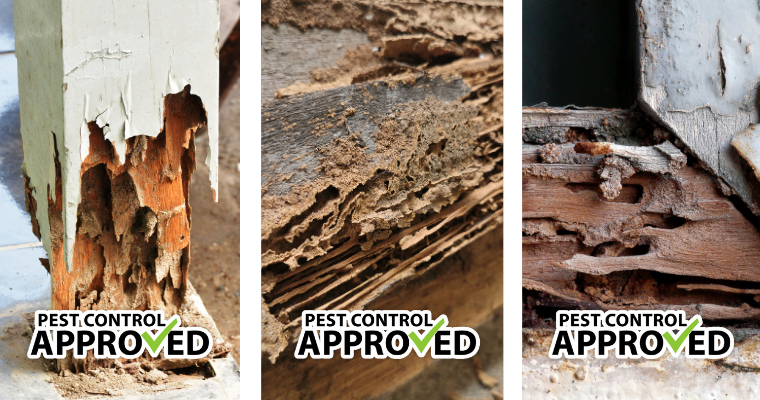
- Investigation
The first thing that each exterminator will do is conduct a detailed inspection of the entire establishment. They will go through all the wooden elements in your home, the structural foundation, and everything else that is necessary to classify the severity of the problem. Due to the termites’ evasive nature, this can cost between $270 and $540, depending on the size of the property.
- Liquid Insecticide
Liquid insecticide is a spray that the exterminator applies directly to the previously identified termite nesting grounds and tunnels. It is a quick and effective way of killing termites. It has an approximate cost of $4 per square foot but, because it is a spot treatment, the cost is generally lower than initially calculated.
- Bait Stations
Using Termite Bait Stations is the cheapest termite removal method. The professionally made bait stations are placed alongside identified tunnels and are known to efficiently attract and eliminate entire colonies; however, this treatment requires constant monitoring of the house for up to a year. Most situations require a set of 10-15 bait stations, but more might be needed depending on the size and intensity of the colony. They have a standard setup and removal cost of $50 per station.
- Heat Treatment
Heat treatment is an ideal option for homeowners who don’t want a chemical-based treatment. In this method, the exterminators raise the temperature of the entire house to that which is lethal for termites for at least 30 minutes. This causes the termites to dry out and die almost immediately. The cost for this treatment is about $1.35 per square foot.
- Fumigation
If the situation cannot be contained by traditional methods, then the exterminators have to use fumigation. Fumigation can cost for up to $4 per square foot. This means that a homeowner may have to pay anywhere between $2700 and $8000, depending on the size of the area. Fumigation can take up to 3 days, so you will also have to temporarily relocate.
What Should You Do Before and After Termite Treatment?
There are many actions that you can take to make your house a termite-free zone, including:
- Prune Trees: Trees are the perfect breeding ground for termites, and trees with extended branches can act as an entry point into your home. Make sure you trim and prune them on a regular basis.
- Notify your Neighbors: Sometimes termites can set up house outside of residential properties and thus endanger the entire neighborhood. A combined effort will help secure your neighborhood against these pests.
- Stay Vigilant: It is important to keep an eye out for pest activity so that, if the problem resurfaces, it can be immediately dealt with during the warranty period.
Frequently Asked Termite Questions
How do I know if I have winged ants or winged termites?
Winged ants and winged termites are similar in shape. It is hard to identify them without taking a close look. Ants have a pinched waist and their wings have different shapes, while winged termites have symmetrical wings. The best way to differentiate between the two is to have a pest control service check it out.
Can termites make their way through concrete?
Unlike wood, plaster, or insulation, termites cannot eat through concrete; however, they only need an opening that is 0.8 mm (1/32nd inch) to crawl through.
How long do termites live?
Unlike most insects, termites can live for up to two years and queen termites can live for decades! On top of this, they reproduce quickly, so a small population can triple within days.
How often should I inspected for termites?
In more humid areas where termites are more prone to fester, it is recommended to have annual termite investigations. If termites are not a common issue in your area, then you can have biennial checkups. If you’ve recently suffered from termites, then we would recommend asking your pest control team for a check-up plan.
Conclusion
Termites are a nuisance and can eat away at the very foundation of your cherished home for years without you even knowing it. There are a number of ways to prevent a termite infestation and keep your house secure.
However, despite all our efforts, we often find ourselves in the midst of a full-blown infestation. There are many traps and insecticides available to remove an infestation but using them effectively is a different story. These home remedies might help but calling in the professionals is always a wise decision. Pest control teams train especially for this purpose, understand the nature of these creatures. Make sure that you get all the details about the exterminator to avoid getting scammed and to ensure the best service.

